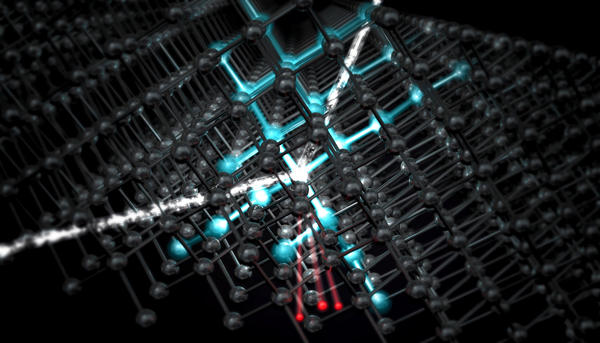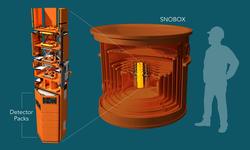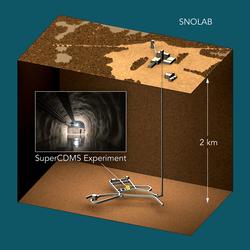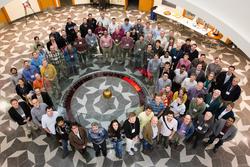Construction Begins on One of the World’s Most Sensitive Dark Matter Experiments

SNOLAB is thrilled to announce that the U.S. Department of Energy has approved funding and start of construction for the SuperCDMS SNOLAB experiment, which will begin operations in the early 2020s to hunt for hypothetical dark matter particles called weakly interacting massive particles, or WIMPs. The experiment will be at least 50 times more sensitive than its predecessor, exploring WIMP properties that can’t be probed by other experiments and giving researchers a powerful new tool to understand one of the biggest mysteries of modern physics.
The DOE’s SLAC National Accelerator Laboratory is managing the construction project for the international SuperCDMS collaboration of 111 members from 26 institutions, which is preparing to do research with the experiment.
“Understanding dark matter is one of the hottest research topics – at SLAC and around the world,” said JoAnne Hewett, head of SLAC’s Fundamental Physics Directorate and the lab’s chief research officer. “We’re excited to lead the project and work with our partners to build this next-generation dark matter experiment.”
With the DOE approvals, known as Critical Decisions 2 and 3, the researchers can now build the experiment. The DOE Office of Science will contribute $19 million to the effort, joining forces with the National Science Foundation ($12 million) and the Canada Foundation for Innovation ($3 million).
An Ultracold Search 6,800 Feet Underground
matter. Due to its gravitational pull on regular matter, dark matter is a key driver for the evolution of the universe, affecting the formation of galaxies like our Milky Way. It therefore is fundamental to our very own existence.
But scientists have yet to find out what dark matter is made of. They believe it could be composed of dark matter particles, and WIMPs are top contenders. If these particles exist, they would barely interact with their environment and fly right through regular matter untouched. However, every so often, they could collide with an atom of our visible world, and dark matter researchers are looking for these rare interactions.

The centerpiece of the SuperCDMS SNOLAB experiment will be four detector towers (left), each containing six detector packs. The towers will be mounted inside the SNOBOX (right), a vessel in which the detector packs will be cooled to almost absolute zero temperature. (Greg Stewart/SLAC National Accelerator Laboratory)
In the SuperCDMS SNOLAB experiment, the search will be done using silicon and germanium crystals, in which the collisions would trigger tiny vibrations. However, to measure the atomic jiggles, the crystals need to be cooled to less than minus 459.6 degrees Fahrenheit – a fraction of a degree above absolute zero temperature. These ultracold conditions give the experiment its name: Cryogenic Dark Matter Search, or CDMS. The prefix “Super” indicates an increased sensitivity compared to previous versions of the experiment.
The collisions would also produce pairs of electrons and electron deficiencies that move through the crystals, triggering additional atomic vibrations that amplify the signal from the dark matter collision. The experiment will be able to measure these “fingerprints” left by dark matter with sophisticated superconducting electronics.
The experiment will be assembled and operated at SNOLAB – 6,800 feet underground inside a nickel mine near the city of Sudbury. It’s the deepest underground laboratory in North America. There it will be protected from high-energy particles, called cosmic radiation, which can create unwanted background signals.

The SuperCDMS dark matter experiment will be located at the Canadian laboratory SNOLAB, 2 kilometers (6,800 feet) underground inside a nickel mine near the city of Sudbury. It’s the deepest underground laboratory in North America. There it will be protected from high-energy particles, called cosmic radiation, which can create unwanted background signals. (Greg Stewart/SLAC National Accelerator Laboratory; inset: SNOLAB)
“We are excited to host this collaboration of over 100 international scientists that will be building and operating this 35 million dollar experiment in Greater Sudbury over the next decade. This is an exciting opportunity for SNOLAB to support this world-leading, high-tech effort that has the potential to fundamentally change our understanding of the Universe” said Dr. Jeter Hall, Director of Research at SNOLAB.
A Strong Collaboration for Extraordinary Science
The international SuperCDMS collaboration currently has 111 members from 26 institutions. (SuperCDMS collaboration)
“We’re fortunate to have a close-knit network of strong collaboration partners, which is crucial for our success,” said KIPAC’s Blas Cabrera, who directed the project through the CD-2/3 approval milestone. “The same is true for the outstanding support we’re receiving from the funding agencies in the U.S. and Canada.”
Fermilab’s Dan Bauer, spokesperson of the SuperCDMS collaboration said, “Together we’re now ready to build an experiment that will search for dark matter particles that interact with normal matter in an entirely new region.”
For more information on the SuperCDMS SNOLAB project and the SuperCDMS collaboration, check out this website: https://supercdms.slac.stanford.edu/

For additional information please contact:
Samantha Kuula
Senior Communications Officer
SNOLAB
(705) 692-7000 x2222